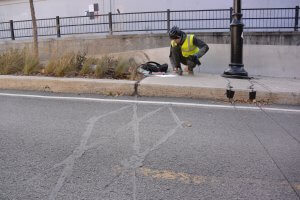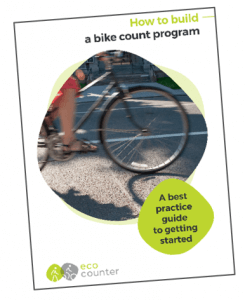We just got back from the League of American Bicyclist’s National Bike Summit and are proud to have sponsored the premier bike advocacy event of the year in the United States!
For those of you who attended the conference, you’ll know that inside your attendee bag there was a fold-out pamphlet from us – a primer detailing the core elements of how to start a bike count program.
Our 'How to build a bicycle count program' primer is making it's way around the @BikeLeague's National Bike Summit this week! Have you dug through your goody bag yet? #NBS2018 #BFC pic.twitter.com/LlCBdB4JIA
— Eco-Counter (@Eco_Counter) March 6, 2018
Couldn’t make to to the Summit? Read on to learn about starting a bike count program.
Why collect bike count data?
Bike count data helps to understand how people are cycling in a community. It can be used to measure the use of bike facilities, evaluate the impact of projects, monitor travel patterns, understand safety trends, prioritize infrastructure, and develop multi-modal transportation models. Bike counts can integrate into planning practices among many transportation agencies.

Why use automated counters?
It can be difficult to measure cycling activity. Relatively lower volumes, different peak patterns and the impact of weather can result in strong daily or seasonal variation. As opposed to labour-intensive manual count data, continuous data give a more thorough understanding of cycling activity, such as a view of seasonal patterns and trends.

Starting a Count Program: Step by Step
- Define need
Let’s get started! Think about the potential uses for bike count data to fill any data gaps or to support stated goals or outcomes. - Assess resources
Consider opportunities and constraints, seek out local knowledge, related projects and review best practices. - Develop a plan
Decide outcomes, identify potential counting sites, research counter options and consider time-frames. - Implement
From a a pilot project or staged rollout to a standalone deployment at full-scale, now’s the time. Go! - Manage the data and counters
Among other practices, this process can include data screening, regular reporting, site visits and test counts. - Show and tell
Share your data and experience collecting it. Interest can stem from potential partners, state or regional authorities, funding agencies, and the public.

Need more information?
This blog post is just a starting point.
Eco-Counter is here to help and ready to share with you a whole host of resources we have accumulated to help you begin counting – from case studies on successful bike count programs to national and local level reports, such as NCHRP 797.
Want to download a full version of our ‘How to build a bike count program’ primer? Get in touch and we’ll send you the full PDF!







1commentaire
Please send the full report ” how to build a count program”
Thank you